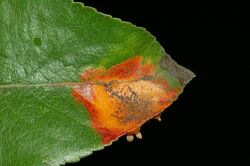Biology:Pucciniomycotina
| Pucciniomycotina | |
|---|---|

| |
| Gymnosporangium fuscum | |
| Scientific classification | |
| Domain: | Eukaryota |
| Kingdom: | Fungi |
| Division: | Basidiomycota |
| Subdivision: | Pucciniomycotina R.Bauer, Begerow, J.P.Samp., M.Weiß & Oberw. (2006)[1] |
| Classes | |
|
Agaricostilbomycetes | |
| Synonyms[2] | |
|
Urediniomycotina | |
Pucciniomycotina is a subdivision of fungus within the division Basidiomycota. The subdivision contains 10 classes, 21 orders, and 38 families.[3] Over 8400 species of Pucciniomycotina have been described - more than 8% of all described fungi.[4][5] The subdivision is considered a sister group to Ustilaginomycotina and Agaricomycotina, which may share the basal lineage of Basidiomycota, although this is uncertain due to low support for placement between the three groups. The group was known as Urediniomycetes until 2006, when it was elevated from a class to a subdivision and named after the largest order in the group, Pucciniales.[1]
Ecology
Pucciniomycotina have a diverse range of ecologies as insect parasites, mycoparasites, and orchid mycorrhiza; some have been detected in soil and water or asymptotic members living on leaves. Most are plant pathogens. Many Pucciniomycotina are rust fungi and are placed in the order Puccinales that contains roughly 7800 species (c. 90% of the group).[4][6] Some members of the group are of economical importance as a pathogen on a wide range of commercial plants, e.g. wheat. Pucciniomycotina is a cosmopolite and exists all over the world.[7]
Morphology
There is a high morphological diversity in the Pucciniomycontina. The sporulating forms range from macrobasidiocarp to single-celled yeasts.[4] The presence of simple septal pores unites Pucciniomycotina and distinguishes it from the sister groups. The predominance of mannose in the cell walls is also a uniting feature of the group.[8]
Life cycle
Some members are only known from their anamorphs, and asexual stages predominate in most; in some species this is the only known form. A striking characteristic of Puccinomycotina is the unique developmental pattern.[4] Rust Fungi or plant pathogenic members in Puccinales have the most complex life cycles known in the fungal kingdom, with five different spore stages.[9] Studies have shown that Puccinales also has one of the largest genomes in the fungi kingdom, and that genome size expansion may be common. This explains the complex life cycles within the group.[7]
References
- ↑ 1.0 1.1 "The simple-septate basidiomycetes: a synopsis". Mycological Progress 5 (1): 41–66. 2006. doi:10.1007/s11557-006-0502-0.
- ↑ "Pucciniomycotina R. Bauer, Begerow, J.P. Samp., M. Weiss & Oberw. 2006". MycoBank. International Mycological Association. http://www.mycobank.org/MycoTaxo.aspx?Link=T&Rec=368587.
- ↑ Wijayawardene, Nalin; Hyde, Kevin; Al-Ani, Laith Khalil Tawfeeq; Somayeh, Dolatabadi; Stadler, Marc; Haelewaters, Danny et al. (2020). "Outline of Fungi and fungus-like taxa". Mycosphere 11: 1060–1456. doi:10.5943/mycosphere/11/1/8.
- ↑ 4.0 4.1 4.2 4.3 The mycota, Vol. VII, Part A: systematics and evolution (2nd ed.). Berlin: Springer-Verlag. 2014. pp. 297–294. ISBN 978-3-642-55318-9.
- ↑ "A new lineage in Pucciniomycotina: class Tritirachiomycetes, order Tritirachiales, family Tritirachiaceae.". Mycologia 103 (6): 1331–40. 2011. doi:10.3852/10-333. PMID 21642341.
- ↑ "An overview of the higher level classification of Pucciniomycotina based on combined analyses of nuclear large and small subunit rDNA sequences". Mycologia 98 (6): 896–905. 2006. doi:10.3852/mycologia.98.6.896. PMID 17486966. http://run.unl.pt/bitstream/10362/3249/1/Sampaio_2006.pdf.
- ↑ 7.0 7.1 Park, Robert F.; Wellings, Colin R. (2012-01-01). "Somatic Hybridization in the Uredinales". Annual Review of Phytopathology 50 (1): 219–239. doi:10.1146/annurev-phyto-072910-095405. PMID 22920559.
- ↑ Prillinger, Hansjörg; Oberwinkler, Franz; Umile, Claudio; Tlachac, Klaudia; Bauer, Robert; Dörfler, Christine; Taufratzhofer, Eduard (1993-01-01). "Analysis of Cell Wall Carbohydrates (neutral Sugars) from Ascomycetous and Basidiomycetous Yeasts with and Without Derivatization". The Journal of General and Applied Microbiology 39 (1): 1–34. doi:10.2323/jgam.39.1.
- ↑ Lutzoni, François; Kauff, Frank; Cox, Cymon J.; McLaughlin, David; Celio, Gail; Dentinger, Bryn; Padamsee, Mahajabeen; Hibbett, David et al. (2004-10-01). "Assembling the fungal tree of life: progress, classification, and evolution of subcellular traits" (in en). American Journal of Botany 91 (10): 1446–1480. doi:10.3732/ajb.91.10.1446. ISSN 0002-9122. PMID 21652303.
Other sources
- M.C. Aime et al.: An overview of the higher level classification of Pucciniomycotina based on combined analyses of nuclear large and small subunit rDNA sequences. Mycologia, Band 98, 2006, S. 896–905.
- Robert Bauer, Dominik Begerow, José Paulo Sampaio, Michael Weiβ, Franz Oberwinkler: The simple-septate basidiomycetes: a synopsis. Mycological Progress, Band 5, 2006, S. 41–66, ISSN 1617-416X, doi:10.1007/s11557-006-0502-0.
External links
- Tree of Life Pucciniomycotina
- http://website.nbm-mnb.ca/mycologywebpages/NaturalHistoryOfFungi/PucciniomycotinaDiscussion.html
- http://tolweb.org/Pucciniomycotina/20528
Wikidata ☰ Q133651 entry
 |

